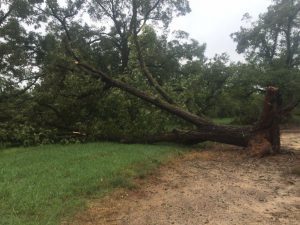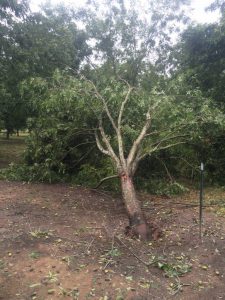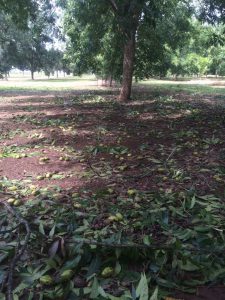Hurricane/Tropical Storm Irma has become the most damaging wind event ever seen by the Georgia pecan industry. Roaring through Georgia on Monday with sustained winds of 20-40 mph and gusts reaching from 50-75 mph, Irma brought damage to virtually every pecan orchard in the state, significantly weakening what was a strong 2017 pecan crop. At this point the most significantly damaged orchards appear to be in the Valdosta area and near Ft. Valley, where individual growers report thousands of trees on the ground. Most growers throughout the state report at least some trees blown down in their orchards in numbers ranging from tens to hundreds. Every orchard has limbs broken and a significant percentage of nuts blown off the tree.
Most of the tree loss has been from trees in the age range of 5 to 25 years or so in age. Many of the old, large mature trees (>60 yrs) that blew down had crown gall, which had weakened the tree. Most of the nuts blown off the trees came from the upper canopy. Fortunately, most remaining trees still have a pretty decent crop. All total, my preliminary estimate is that at least 30% of Georgia’s pecan crop has been lost.
Growers should take photos of their damage and report it to their local FSA office in order to receive financial assistance with cleanup. Cleanup funds normally pay 75% of the USDA-set cost of a mature tree ($300) up to a maximum of $200,000 per entity. Younger trees will be valued at varying levels depending upon age. In addition, the Tree Assistance Program (TAP) will pay for tree loss when 15% or more of the orchard is destroyed. This pays 65% of the cost of the tree up to a maximum of $120,000 per entity.
This money is not available immediately but your FSA office will gather your report. Requests for cleanup funds are made to Congress and they will then appropriate the funds so it may take a while.
Growers have many questions regarding how to handle fallen trees and the mass of green nuts blown from the trees. The success of righting blown down trees varies considerably with age of the tree. Trees less than 8-10 years old (trunk diameter < about 10 inches) can generally be righted with pretty good success, if leaning less than 45 degrees. Success rate is highly variable when leaning more than 45 degrees. Success of righting these trees will be much greater when trees are pruned back as if they were to be transplanted with a tree spade because the newly-limited root system must be able to support the tree that remains. The larger the tree, the more you should prune off when righting.
Uprooted trees or those lying flat on the ground should be removed, especially large, mature trees. Such trees often never perform as they should and will be likely to be blown down again at a later date. Uprooted trees usually exhibit visible broken roots on the side opposite of the direction of fall. The major roots on the opposite side of the tree are also generally broken as well. Such trees usually have much more root damage than is apparent.
I’ve had many questions about salvaging the green nuts blown onto the ground and having them de-shucked. In most cases, the expense involved in this will outweigh the benefit. While there are a significant number of nuts on the ground, in most cases, the volume will be less than most growers think. Pawnee shucks were splitting or open and many of these nuts came out of the shuck and are on the ground. Many would have been ready for harvest this week so these nuts can be salvaged once the debris is cleaned up. Early October harvest nuts like Caddo, Oconee, Elliott, Moneymaker etc. may be far enough along to attempt de-shucking if growers are inclined to do so. However, they need to bear in mind the cost of an additional harvest, transport, cleaning, and de-shucking when making this decision. Later varieties like Desirable, Stuart, Cape Fear, Sumner,. etc. are likely not mature enough for de-shucking even though the kernels may be filled out. If the nut does not pop out of the shuck when stepped on or rolled with your foot or if the shell is still white and the markings have not developed growers should not attempt de-shucking.
There is potential for further damage to appear at a later date from nuts getting knocked around in the storm. This often bruises or damages the shuck and affects development or maturity of the nut and may lead to stick-tights. However, my early observations are that this bruising is minimal. I do not see a lot of bruising as of yet on the shucks so I am hopeful but it is still a bit early to tell whether or not we will escape this type of damage.
All in all, the Georgia pecan industry has suffered a significant blow but it could have been much worse than it is given the severity of the storm.



